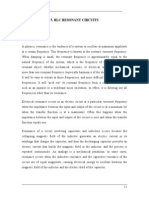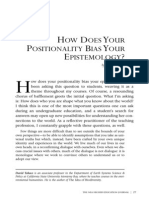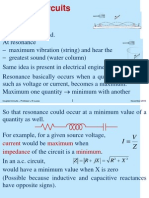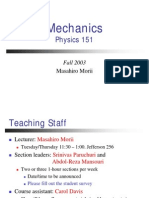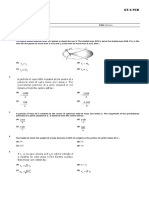Lecture 03
Uploaded by
nghaLecture 03
Uploaded by
nghaMechanics
Physics 151
Lecture 3
Lagranges Equations
(Goldstein Chapter 1)
Hamiltons Principle
(Chapter 2)
What We Did Last Time
! Discussed multi-particle systems
! Internal and external forces
! Laws of action and reaction
! Introduced constraints
! Generalized coordinates
! Introduced Lagranges Equations
! ... and didnt do the derivation
"Lets pick it up and start from there
Todays Goals
! Derive Lagranges Eqn from Newtons Eqn
! Use DAlemberts principle
! There will be a few assumptions
! Will make them clear as we go
! Introduce Hamiltons Principle
! Equivalent to Lagranges Equations
! Which in turn is equivalent to Newtons Equations
! Does not depend on coordinates by construction
! Derivation in the next lecture
Lagranges Equations
! Express L = T V in terms of generalized coordinates
, their time-derivatives , and time t
! The potential V = V(q, t) must exist
! i.e. all forces must be conservative
0
j j
d L L
dt q q
| |
=
|
|
\ .
!
( , , ) L q q t T V
!
Kinetic energy
Potential energy
Lagrangian
Recipe
{ }
j
q { }
j
q
!
Virtual Displacement
! Consider a system with constraints
! Ordinary coordinates r
i
(i = 1...N)
! Generalized coordinates q
j
(j = 1...n)
! Imagine moving all the particles
slightly
! Note that r
i
must satisfy the constraints
1 1 1 2
2 2 1 2
1 2
( , ,..., , )
( , ,..., , )
( , ,..., , )
n
n
N N n
q q q t
q q q t
q q q t
=
r r
r r
r r
"
i i i
+ r r r
Virtual displacement
i
i j
j
j
q
q
r
r
3N coordinates
not independent
n coordinates
independent
j j j
q q q +
! From Newtons Equation of Motion
! Part of the force F
i
must be due to constraints
! Applied force is known
! Constraint force f
i
(usually) does no work
! Movement is perpendicular to the force
! Exception: friction
! Now multiply by r
i
and sum over i
( ) a
i i i
= + F F f
DAlemberts Principle
i i
= F p
!
0
i i
= F p
!
( ) ( )
1 2
( , ,..., ,..., , )
a a
i i i N
t = F F r r r r
applied force constraint force
0
i i
= f r
( )
0
a
i i i
+ = F f p
!
DAlemberts Principle
! Force of constraints dropped out because
! Called DAlemberts Principle (1743)
! Now we switch from r
i
to q
j
! Unit of Q
j
not always [force]
! Q
j
q
j
is always [work]
( )
( ) 0
a
i i i
i
=
F p r
!
0
i i
= f r
1st term
i
i j j j
i j j
j
q Q q
q
= =
r
F
i
j i
i
j
Q
q
r
F
Generalized force
constraint force is out of the game.
You can forget (a)
DAlemberts Principle
! A bit of work can show
! DAlemberts Principle becomes
,
2nd term
i i
i i i j i i j
i i j i j
j j
q m q
q q
= = =
r r
p r p r
! ! !!
2 2
2 2
i i i
i
j j j
v v d
q dt q q
(
| | | |
(
| |
( \ . \ .
r
r
!!
!
j
j
j j
d T T
q
dt q q
| |
=
|
`
|
\ .
)
!
0
j j
j
j j
d T T
Q q
dt q q
(
| |
=
(
|
`
|
(
\ .
)
!
2
2
i
i
mv
T
Lagranges Equations
! Generalized coordinates q
j
are independent
! Assume forces are conservative
0
j j
j
j j
d T T
Q q
dt q q
(
| |
=
(
|
`
|
(
\ .
)
!
These are free
j
j j
d T T
Q
dt q q
| |
=
|
|
\ .
!
Almost there!
i i
V = F
i i
j i i
i i
j j j
V
Q V
q q q
= =
r r
F
Throw this
back in
Lagranges Equations
! Assume that V does not depend on
( )
0
j j
T V
d T
dt q q
| |
=
|
|
\ .
!
j
q
!
0
j
V
q
!
0
j j
d L L
dt q q
| |
=
|
|
\ .
!
Finally
( , , ) ( , )
j j j
L T q q t V q t =
!
Done!
Assumptions We Made
! Constraints are holonomic
! We always assume this
! Constraint forces do no work
! Forget frictions
! Applied forces are conservative
! Lagranges Eqn. itself is OK if V depends explicitly on t
! Potential V does not depend on
1 2
( , ,..., , )
i i n
q q q t = r r
0
i i
= f r
i i
V = F
j
q
! 0
j
V
q
!
Will review the last assumption later
Example: Time-Dependent
! Transformation functions may depend on t
! Generalized coordinate system may move
! E.g. coordinate system fixed to the Earth
! An example
( , )
i i j
q t = r r
mass m on a rail
spring constant K
natural length l
angular velocity
l + r
Example: Time-Dependent
! Transformation functions:
! Kinetic energy
! Potential energy
( ) cos
( ) sin
x l r t
y l r t
= +
= +
{ } { }
2 2 2 2 2
( )
2 2
m m
T x y r l r = + = + +
! ! !
2
2
K
V r =
{ }
2 2 2 2
( )
2 2
m K
L r l r r = + +
!
2
( ) 0
d L L
mr m l r Kr
dt r r
(
= + + =
(
!!
!
Lagranges Equation
Example: Time-Dependent
! If K > m
2
, a harmonic oscillator with
! Center of oscillation is shifted by
! If K < m
2
, moves away exponentially
! If K = m
2
, velocity is constant
! Centripetal force balances with the spring force
2
( ) 0
d L L
mr m l r Kr
dt r r
(
= + + =
(
!!
!
2
2
2
( ) 0
m l
mr K m r
K m
| |
+ =
|
\ .
!!
2
K m
m
=
Note on Arbitrarity
! Lagrangian is not unique for a given system
! If a Lagrangian L describes a system
! One can prove
( , ) dF q t
L L
dt
= +
works as well for any function F
0
d dF dF
dt q dt q dt
| |
| | | |
=
| | |
\ . \ .
\ .
!
dF F F
q
dt q t
= +
!
using
Assumptions We Made
! Constraints are holonomic
! We always assume this
! Constraint forces do no work
! Forget frictions
! Applied forces are conservative
! Lagranges Eqn. itself is OK if V depends explicitly on t
! Potential V does not depend on
1 2
( , ,..., , )
i i n
q q q t = r r
0
i i
= f r
i i
V = F
j
q
! 0
j
V
q
!
Lets review the last assumption
Velocity-Dependent Potential
! We assumed and so that
! We could do the same if we had
0
j
V
q
!
j
j j
d T T
Q
dt q q
| |
=
|
|
\ .
!
( ) ( )
0
j j
d T V T V
dt q q
| |
=
|
|
\ .
!
This had to be 0
j
j j
U d U
Q
q dt q
| |
= +
|
|
\ .
!
( , , )
j j
U U q q t =
!
Generalized,
or velocity-
dependent
potential
( , , ) ( , , )
j j j j
L T q q t U q q t =
! !
j
j
V
Q
q
EM Force on Particle
! Lorentz force on a charged particle
! E and B fields are given by
! Force is v-dependent "Need a v-dependent potential
! Lagrangian is
[ ( )] q = + F E v B
t
A
E
= B A
U q q = A v works
check
2
1
2
L mv q q = + A v
Velocity-dependent.
Cant find a usual
potential V
Physics 15b
Monogenic System
! If all forces in a system are derived from a generalized
potential,
its called a monogenic system
! U is a function of
! Lorentz force is monogenic
! A monogenic system is conservative only if
! Or
! Lagranges Equation works on a monogenic system
j
j j
U d U
Q
q dt q
| |
= +
|
|
\ .
!
, , q q t
!
( ) U U q =
0
U U
q t
= =
!
Hamiltons Principle
! We derived Lagranges Eqn from Newtons Eqn using
a differential principle
! DAlemberts principle uses infinitesimal displacements
! Its possible to do it with an integral principle
Hamiltons Principle
Configuration Space
! Generalized coordinates q
1
,...,q
n
fully describe the
systems configuration at any moment
! Imagine an n-dimensional space
! Each point in this space (q
1
,...,q
n
)
corresponds to one configuration of the system
! Time evolution of the system "A curve in the
configuration space
configuration
space
real space configuration space
Action Integral
! A system is moving as
! Lagrangian is
! Action I depends on the entire path from t
1
to t
2
! Choice of coordinates q
j
does not matter
! Action is invariant under coordinate transformation
( ) 1...
j j
q q t j n = =
( , , ) ( ( ), ( ), ) L q q t L q t q t t =
! !
integrate
2
1
t
t
I Ldt =
Action, or action integral
Hamiltons Principle
! This is equivalent to Lagranges Equations
! We will prove this
! Three equivalent formulations
! Newtons Eqn depends explicitly on x-y-z coordinates
! Lagranges Eqn is same for any generalized coordinates
! Hamiltons Principle refers to no coordinates
! Everything is in the action integral
The action integral of a physical system is stationary
for the actual path
We will also define stationary
Hamiltons Principle is more fundamental
probably...
Stationary
! Consider two paths that are close to each other
! Difference is infinitesimal
! Stationary means that the
difference of the action integrals is
zero to the 1st order of q(t)
! Similar to first derivative = 0
! Almost same as saying minimum
! It could as well be maximum
configuration space
1
t
2
t
( ) q t
( ) ( ) q t q t +
2 2
1 1
( , , ) ( , , ) 0
t t
t t
I L q q q q t dt L q q t dt = + + =
! ! !
1 2
( ) ( ) 0 q t q t = =
Infinitesimal Path Difference
! Whats q(t)?
! Its arbitrary sort of
! It has to be zero at t
1
and t
2
! Its well-behaving
! Have to shrink it to zero
! Trick: write it as
! is a parameter, which well make "0
! (t) is an arbitrary well-behaving function
configuration space
1
t
2
t
( ) q t
( ) ( ) q t q t +
Continuous, non-singular,
continuous 1
st
and 2
nd
derivatives
( ) ( ) q t t =
1 2
( ) ( ) 0 t t = =
Dont worry
too much
Hamilton " Lagrange
! To derive Lagranges Eqns from Hamiltons Principle
! Define
! I is then
! We must show that leads to Lagranges Eqns
2
1
( ) ( ( ) ( ), ( ) ( ), )
t
t
I L q t t q t t t dt + +
! !
2 2
1 1
( , , ) ( , , ) 0
t t
t t
I L q q q q t dt L q q t dt = + + =
! ! !
[ ]
0
lim ( ) (0) I I
0
I
d
| |
|
\ .
0
0
I
| |
=
|
\ .
A bit of work. Will do it on Thursday
Summary
! Derived Lagranges Eqn from Newtons Eqn
! Using DAlemberts Principle Differential approach
! Assumptions we made:
! Constraints are holonomic "Generalized coordinates
! Forces of constraints do no work "No frictions
! Other forces are monogenic "Generalized potential
! Introduced Hamiltons Principle
! Integral approach
! Defined the action integral and stationary
! Derivation in the next lecture
j
j j
U d U
Q
q dt q
| |
= +
|
|
\ .
!
You might also like
- Galvanic Cells, The Nernst Equation: de Juan, Jarell PNo ratings yetGalvanic Cells, The Nernst Equation: de Juan, Jarell P5 pages
- Parts - Hardware Guide - 6.302.0x Courseware - EdXNo ratings yetParts - Hardware Guide - 6.302.0x Courseware - EdX14 pages
- Air Circuit Breakers: CG International Division100% (2)Air Circuit Breakers: CG International Division9 pages
- Limits, Continuity and Differentiability - GATE Study Material in PDF33% (3)Limits, Continuity and Differentiability - GATE Study Material in PDF9 pages
- Paper 3 Exploration Questions EIGHT QUESTIONSNo ratings yetPaper 3 Exploration Questions EIGHT QUESTIONS20 pages
- Qip Lecture On: Electrical & Electronics Circuit SimulationNo ratings yetQip Lecture On: Electrical & Electronics Circuit Simulation28 pages
- Numerical Approximation - Bisection Method, Heron's Method For Finding Square Roots For Middle School StudentsNo ratings yetNumerical Approximation - Bisection Method, Heron's Method For Finding Square Roots For Middle School Students15 pages
- Computer Aided Design 2 (E3004) : Ac AnalysisNo ratings yetComputer Aided Design 2 (E3004) : Ac Analysis14 pages
- Beer Lambert'S Law: Dr. Swastika Das Professor of ChemistryNo ratings yetBeer Lambert'S Law: Dr. Swastika Das Professor of Chemistry19 pages
- 2018 Sec 1 Express Science SA1 Bedok View SecondaryNo ratings yet2018 Sec 1 Express Science SA1 Bedok View Secondary19 pages
- Modeling of Impact Dynamics of A Tennis Ball With A Flat SurfaceNo ratings yetModeling of Impact Dynamics of A Tennis Ball With A Flat Surface182 pages
- How Doesyour Positionality Bias Your Epistemology?No ratings yetHow Doesyour Positionality Bias Your Epistemology?12 pages
- Experiment 4 Electrogravimetry - Determination of AvogadroNo ratings yetExperiment 4 Electrogravimetry - Determination of Avogadro7 pages
- Concentration Dependence of CuSO4 Electrolysis (With Model Fitting) (Tony 2016)No ratings yetConcentration Dependence of CuSO4 Electrolysis (With Model Fitting) (Tony 2016)11 pages
- Adsorption of Copper Ions in Aqueous Media Using Tea Waste and Sawdust As An AdsorbentNo ratings yetAdsorption of Copper Ions in Aqueous Media Using Tea Waste and Sawdust As An Adsorbent6 pages
- Materials Science and Engineering An Introduction - Complete Solutions To Selected Problems - Callister - 6Th EdNo ratings yetMaterials Science and Engineering An Introduction - Complete Solutions To Selected Problems - Callister - 6Th Ed4 pages
- Calc Essay 1 Solids of Revolution AugustNo ratings yetCalc Essay 1 Solids of Revolution August18 pages
- Chapter 4. Lagrangian Dynamics: 4.1 Important Notes On NotationNo ratings yetChapter 4. Lagrangian Dynamics: 4.1 Important Notes On Notation35 pages
- Topic 11.2 - Power Generation and Transmission - AHL100% (1)Topic 11.2 - Power Generation and Transmission - AHL49 pages
- Series RLC Circuit and RLC Series Circuit AnalysisNo ratings yetSeries RLC Circuit and RLC Series Circuit Analysis13 pages
- Mathematical Modelling. MA - Maths PreviousNo ratings yetMathematical Modelling. MA - Maths Previous223 pages
- 11th English Lang & Lit - Paper 2 - Question BankNo ratings yet11th English Lang & Lit - Paper 2 - Question Bank1 page
- L211 Series Resonance and TimeFrequency Response of Passive Networks PDF100% (1)L211 Series Resonance and TimeFrequency Response of Passive Networks PDF25 pages
- Presented By:: Minhaj Fathima (09881A0466) P.Naveen Kumar (09881A0480)No ratings yetPresented By:: Minhaj Fathima (09881A0466) P.Naveen Kumar (09881A0480)16 pages
- EE2092!2!2011 Coupled Circuits Dependant SourcesNo ratings yetEE2092!2!2011 Coupled Circuits Dependant Sources100 pages
- Sun Tao, Chinese Learning Cards for HSK. 孙涛 HSK汉字学习卡片No ratings yetSun Tao, Chinese Learning Cards for HSK. 孙涛 HSK汉字学习卡片281 pages
- Internship Report ON NTDC Multan: NFC Institute of Engineering and Technology MultanNo ratings yetInternship Report ON NTDC Multan: NFC Institute of Engineering and Technology Multan16 pages
- AY - XP 081013 CE AE-X 081013 BE S Manual 2004-s2No ratings yetAY - XP 081013 CE AE-X 081013 BE S Manual 2004-s252 pages
- High Voltage Testing of Electrical ApparatusNo ratings yetHigh Voltage Testing of Electrical Apparatus29 pages
- Magnetic Particle Testing (MT) Level - 2 Specific ExamNo ratings yetMagnetic Particle Testing (MT) Level - 2 Specific Exam7 pages
- Sensorless MPPT Technique For Gridconnec PDFNo ratings yetSensorless MPPT Technique For Gridconnec PDF123 pages
- A 3-kW Wireless Power Transfer System For Sightseeing Car Supercapacitor ChargeNo ratings yetA 3-kW Wireless Power Transfer System For Sightseeing Car Supercapacitor Charge16 pages
- 7MBR25SA120: IGBT MODULE (S Series) 1200V / 25A / PIMNo ratings yet7MBR25SA120: IGBT MODULE (S Series) 1200V / 25A / PIM8 pages
- Brochures - FRENIC-Ace For Solar PumpingNo ratings yetBrochures - FRENIC-Ace For Solar Pumping2 pages
- Electrostatic Generator and Electronic TransformerNo ratings yetElectrostatic Generator and Electronic Transformer12 pages
- To Analyze The Sinusoidal Response of RLC CircuitNo ratings yetTo Analyze The Sinusoidal Response of RLC Circuit4 pages
- Basic Engineering Physics Wbut2013 3nbsped 9781259097478 1259097471 CompressNo ratings yetBasic Engineering Physics Wbut2013 3nbsped 9781259097478 1259097471 Compress422 pages
- Constituent Pure Liquid - Capacity Certified (Pure Toluene) Pressure Relief Valve PSV 102No ratings yetConstituent Pure Liquid - Capacity Certified (Pure Toluene) Pressure Relief Valve PSV 1026 pages
- Converting Existing Synchronous Generators Into Synchronous Condensers100% (1)Converting Existing Synchronous Generators Into Synchronous Condensers2 pages
- Galvanic Cells, The Nernst Equation: de Juan, Jarell PGalvanic Cells, The Nernst Equation: de Juan, Jarell P
- Parts - Hardware Guide - 6.302.0x Courseware - EdXParts - Hardware Guide - 6.302.0x Courseware - EdX
- Limits, Continuity and Differentiability - GATE Study Material in PDFLimits, Continuity and Differentiability - GATE Study Material in PDF
- Qip Lecture On: Electrical & Electronics Circuit SimulationQip Lecture On: Electrical & Electronics Circuit Simulation
- Numerical Approximation - Bisection Method, Heron's Method For Finding Square Roots For Middle School StudentsNumerical Approximation - Bisection Method, Heron's Method For Finding Square Roots For Middle School Students
- Beer Lambert'S Law: Dr. Swastika Das Professor of ChemistryBeer Lambert'S Law: Dr. Swastika Das Professor of Chemistry
- 2018 Sec 1 Express Science SA1 Bedok View Secondary2018 Sec 1 Express Science SA1 Bedok View Secondary
- Modeling of Impact Dynamics of A Tennis Ball With A Flat SurfaceModeling of Impact Dynamics of A Tennis Ball With A Flat Surface
- How Doesyour Positionality Bias Your Epistemology?How Doesyour Positionality Bias Your Epistemology?
- Experiment 4 Electrogravimetry - Determination of AvogadroExperiment 4 Electrogravimetry - Determination of Avogadro
- Concentration Dependence of CuSO4 Electrolysis (With Model Fitting) (Tony 2016)Concentration Dependence of CuSO4 Electrolysis (With Model Fitting) (Tony 2016)
- Adsorption of Copper Ions in Aqueous Media Using Tea Waste and Sawdust As An AdsorbentAdsorption of Copper Ions in Aqueous Media Using Tea Waste and Sawdust As An Adsorbent
- Materials Science and Engineering An Introduction - Complete Solutions To Selected Problems - Callister - 6Th EdMaterials Science and Engineering An Introduction - Complete Solutions To Selected Problems - Callister - 6Th Ed
- Chapter 4. Lagrangian Dynamics: 4.1 Important Notes On NotationChapter 4. Lagrangian Dynamics: 4.1 Important Notes On Notation
- Topic 11.2 - Power Generation and Transmission - AHLTopic 11.2 - Power Generation and Transmission - AHL
- Series RLC Circuit and RLC Series Circuit AnalysisSeries RLC Circuit and RLC Series Circuit Analysis
- L211 Series Resonance and TimeFrequency Response of Passive Networks PDFL211 Series Resonance and TimeFrequency Response of Passive Networks PDF
- Presented By:: Minhaj Fathima (09881A0466) P.Naveen Kumar (09881A0480)Presented By:: Minhaj Fathima (09881A0466) P.Naveen Kumar (09881A0480)
- Sun Tao, Chinese Learning Cards for HSK. 孙涛 HSK汉字学习卡片Sun Tao, Chinese Learning Cards for HSK. 孙涛 HSK汉字学习卡片
- Internship Report ON NTDC Multan: NFC Institute of Engineering and Technology MultanInternship Report ON NTDC Multan: NFC Institute of Engineering and Technology Multan
- Magnetic Particle Testing (MT) Level - 2 Specific ExamMagnetic Particle Testing (MT) Level - 2 Specific Exam
- A 3-kW Wireless Power Transfer System For Sightseeing Car Supercapacitor ChargeA 3-kW Wireless Power Transfer System For Sightseeing Car Supercapacitor Charge
- 7MBR25SA120: IGBT MODULE (S Series) 1200V / 25A / PIM7MBR25SA120: IGBT MODULE (S Series) 1200V / 25A / PIM
- Electrostatic Generator and Electronic TransformerElectrostatic Generator and Electronic Transformer
- Basic Engineering Physics Wbut2013 3nbsped 9781259097478 1259097471 CompressBasic Engineering Physics Wbut2013 3nbsped 9781259097478 1259097471 Compress
- Constituent Pure Liquid - Capacity Certified (Pure Toluene) Pressure Relief Valve PSV 102Constituent Pure Liquid - Capacity Certified (Pure Toluene) Pressure Relief Valve PSV 102
- Converting Existing Synchronous Generators Into Synchronous CondensersConverting Existing Synchronous Generators Into Synchronous Condensers


















